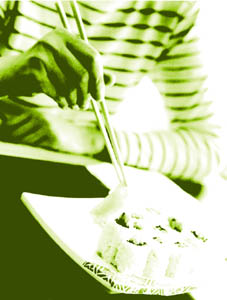![[Metroactive Dining]](/dining/gifs/dining468.gif)
[ Dining Index | Silicon Valley | Metroactive Home | Archives ]
 My Sushi, My Self
My Sushi, My Self
From spam to nigiri with Todd Inoue
Photograph by Erika Pino
SUSHI IS my thing. I never order off the menu. I order off the chalkboard with the funky lettering. I make intricate origami chopstick stands with the paper wrapper. I can tell the harvest season of the rice just by touching it. I download the latest updates from Tokyo's famous Tsukiji fish market directly onto my PDA. I know vinegar origin by smell. OK, I'm playing--sort of--but sushi is in my blood. Growing up, sushi was finger food for birthdays, graduations and New Year's Day. I remember how the windows would steam and the house would fill with vinegar aroma when my mom and aunts fanned the rice to make it glisten. I fondly recall the Spam musubis we hauled to the beach and baseball games, and the futomaki and inari for New Year's Day spreads. Sushi was our heritage and our history. Today, when the sushi craving hits, it's easier to head for the sushi bar than to call Mom. The sushi bar is the ultimate open kitchen, where food is prepared in front of your eyes. At peak hour, it's like watching your favorite band jam, or a DJ caught up in the mix. The sushi bar takes on a rhythmic intensity that's electric and addictive. It wasn't easy to break in. The sushi bar can be an intimidating place, especially for the first-timer. There are lumps of raw fish, squid tentacles, piles of crazy-looking stuff. There are herring roe, salmon roe, soft-shell crabs, fermented soybeans (natto, my favorite), gobo stalks, shiso leafs and stoic chefs creating edible art. It's culture shock. I'll never forget the first all-nigiri platter I ordered. It was scary, but it was such a treat--the many textures, tastes and sensations. It was visually appealing, like eating a delicate diorama. But like any new experience, it required practice and a sense of adventure. And it helps to know some history. In Japan, sushi making is an honorable and closely held tradition. Budding chefs spend years washing dishes, making rice and cleaning fish before they can prepare sushi for customers. The head chefs keep techniques to themselves. Shin Kaneoya, owner and sushi chef of Akane, in Los Altos, and Ryoki Nishimoto, sushi chef at Kubota, in San Jose, had to sneak glimpses of the head sushi chef to learn the advanced techniques. "You have to watch how they do, and steal, otherwise they don't teach you," says Kaneoya, who worked in Tokyo restaurants before coming to America in 1981. "They teach you basic things: how to slice, that kind of stuff. You can learn if you read a book, but other techniques you had to steal." "You had to sneak the technique," adds Nishimoto, a 10-year sushi veteran. "They had to learn that way, too." Sushi chefs are up early to survey the day's selection, and they stay until the last customer is gone. In her book Sushi, author Mia Detrick compares sushi chefs to samurai warriors. "Chefs uphold an ideal they call inase, a snappy, clean-cut kind of machismo," she writes. "They wear spotless jackets, and often sport no-nonsense crew cuts and hajimaki, the knotted headband that samurai wore to indicate they were prepared for battle." In America, society allows single diners to occupy a table and eat in silence--and nobody will think twice. In Japan, eating out is a social event. If you're sitting alone, you'll invariably be invited to join another table. A good sushi bar facilitates conversation and laughs. The worst thing a customer can do is bring a newspaper or cell phone. It doesn't take two Valiums and killer chopstick skills to break into this environment. The word from the chefs? Relax. Sit down. Ask questions. If you're new to sushi, just tell the chef, and he'll prepare some easy-to-try broiled eel or cucumber. Pretty soon, you'll graduate to maguro or ebi before hitting the uni and tobiko. Nishimoto suggests newbies should try each item three times to get over their fears. "People are afraid the first time seeing different stuff," he says. "I remember when I tried grits for the first time. I was, like, 'What the hell?' It was a different food culture." "Talk to the sushi chefs, make conversation," Kaneoya advises. "Enjoy the food, drink sake, just enjoy." Words to live by.
Hand To Mouth: The Ultimate Silicon Valley Sushi Listings. Rockin' Maki: Sushi rolls into area nightclubs. Model Food: The art of faking it. Know Your Roll: A beginner's guide to sushi bar etiquette. Sushi Sing-Along! Musicians pay homage to fish and rice. Nori Story: Seaweed is one of the most popular foods on earth. Whassup, Wasabi? A few words about the hot, sweet condiment. Sake To Me: Some like it hot. Rice is Nice: The making and shaping of sushi rice is an age-old craft.
Send a letter to the editor about this story via email . [ Silicon Valley | Metroactive Home | Archives ]
|
From the May 2-8, 2002 issue of Metro, Silicon Valley's Weekly Newspaper.
Copyright © Metro Publishing Inc. Metroactive is affiliated with the Boulevards Network.
For more information about the San Jose/Silicon Valley area, visit sanjose.com.
![[line]](/gifs/line.gif)